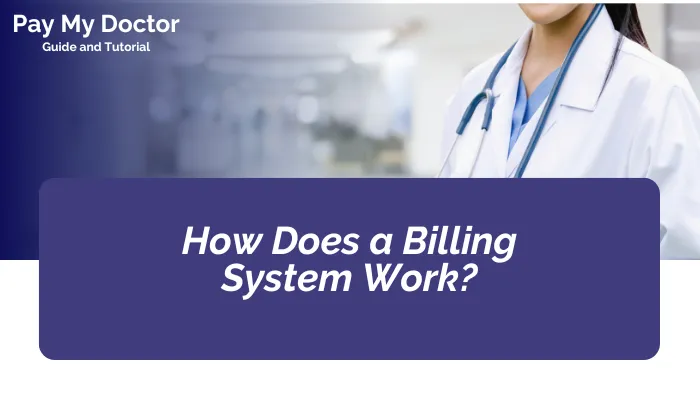How does a billing system work? This is a question that many people often ask, especially when dealing with payments for services or products. From small businesses to large corporations, billing systems are vital for ensuring accurate invoicing, easy payment collection, and seamless operations.
In this blog, we will explore the key components of a billing system, how it works, and why it is so crucial for both businesses and customers alike. Let’s dive into it.
In platforms like PayMyDoctor, understanding how a billing system functions can help customers manage their medical expenses effectively. Now, let’s break down the process step by step.

How Does a Billing System Work?
Having understood what billing systems are, let’s now get into the specifics of how a billing system works. A brief outline is provided below:
Step 1: Gathering Client Details
The billing process begins with obtaining information about a potential client. Such information is crucial to any business whether for a one-time service, or subscription basis. The particulars include the following:
- Customer’s name
- Customer’s contact information ( email, phone number)
- Customer billing address
- Customer’s preferred payment method (credit card, direct debit etc)
Step 2: Creating An Invoice
A client Bill will be created after the payment of the service provided, or after selling a product. This usually contains:
- List of all the services provided or the products sold
- Weighted average cost of the item sold or service provided per the list of costs incurred
- Gross total cost less the aggregate of any deductions including tax where applicable.
- Details surrounding any accounts payable including payment due dates and any penalties for late payment if any.
Step 3: Customer Payment Cycle
An invoice received by a client will make it possible for the client to use whichever means available to pay. Billing systems are known to cater for:
- Use of credit or debit cards
- Use of payment gateways that facilitate internet transaction, e.g. PayPal, Stripe etc
- Payment through bank transfers
- Payment by cash
These payments will be processed by the billing system after ensuring all accounts are correctly transferred to facilitate adequate completion.
4. Recording Transactions
Every time a payment is received, the system captures this transaction to the customer’s account. Therefore, this makes it possible for the amount that is owed to be decreased and the system to be up to date with the current balance.
5. Sending Payment Confirmation
Once a payment has been completed many customers get a confirmation receipt. For example:
- Email Notifications
- SMS Messages
- Digital Receipts through web portals
This step gives the client the confidence that the transaction has about gone through without any issues.
6. Outstanding Payment Reminders
A client who has not made a payment by the set due date is an alarming state and in such cases, this can alert the client regarding their overdue payment through a series of reminders.
This normal process, however, involves various phases such as the issuing of a bill and even the receiving of a payment.
Types of Billing Systems
There are a variety of billing systems that businesses use today inclusive of the tough challenges faced, there are advantages to using a billing system specifically in relation to the type of invoice a company generates and the type of bill they need to produce , Lets look at the Major types :
1. Manual Billing Systems
This usually includes a time consuming and less efficient process of conventional paper invoices and bill payments for a company as most operated previously. It’s a slow process and due to such inefficiencies many companies have chose a automated solution.
2. Automated Billing Systems
Most enterprises today have automated billing systems. These can be linked to accounting systems, CRM systems as well as payment processors for efficiency.
3. Recurring Billing Systems
Recurring billing is a must for businesses engaged in subscription based services like streaming, gyms, etc. This system can charge customers at a frequency that they set, which could be monthly or every year.
4. Cloud Based Billing Systems
Cloud-helped applications take billing information from offsite databases and enable easy paying online to client and easy range out of the office to businesses.
Every billing system solves different problems but they can be rewarded for meeting the best suitable requirement of the business and that of the customer.
Advantages of Using a Billing System
The usage of a billing system has plenty of uses for businesses and customers alike. These include the following among others:
1. Accuracy
Billing done manually comes with the risk of human error such as invoices not being correctly calculated or being left out. By having billing software, it will automate the entire process thus lowering the errors and ensuring the client is always correctly billed.
2. Time Efficiency
Automating the process of billing reduces the number of resources wasted. Invoices can be automatically created, payments are done as soon as the invoice is made and several clicks can create hundreds of reports.
3. Enhanced Record Maintenance
Billing systems are essential for recording all the completed transactions in a more digital way and enable easy payment tracking, payment history imaging, and account reconciliation.
4. Increased Cash Inflows
Timely and accurate invoicing helps customers pay their bills on time and this way creates an organization that has great cash inflows. In some businesses like the health care services , it helps for the peace of mind knowing that the payments for the medical services will be done without delays (e.g. PayMyDoctor ).
5. Customers’ Happiness
Customers simply do not want to see the bill not ready on time and auto systems do that for them by sending accurate bills at the right time, reminders and, hence, receipts, increasing their happiness.
With better accuracy and time savings and customer satisfaction, the benefits a billing system brings are numerous as it provides a more efficient manner of performing financial tasks for the company and simplifying the payment’s methods for the client.
Working of Billing System in Healthcare
In the medical sector, billing systems are crucial in settling payments for services that involve a doctor, medical examination or treatment. So how does a billing system work in this sector? The correct response is as below:
1. Deliver Service
The asked service forms that were delivered include consultations, procedures or the asking party was given medications
2. Send Invoice to the Insurance Provider
In many cases it will be the case that the first invoice will be sent by a billing system to an insurance company. The check whether the patient has coverage and the claim for payment is submitted.
3. Release of Payment Responsibility to the Patient
Once the invoice is cleared by the insurance provider, the money owed by a patient is collected. This is where the billing system assists in maintaining the receipt of the payment made, the production of invoice and the direct collection of the payment from patients.
4. Payment Techniques
There are several methods in which a patient can make payment such as through the online portal, insurance payment, credit card payment and so forth.
In healthcare, billing implements refrain a business between patients, providers and insurance companies. Knowing this allows healthcare providers and patients to be financially efficient on the billing side.
Conclusion
To wrap up, how does a billing system work? It’s a process that helps businesses create invoices, collect payments, and maintain accurate financial records. From small businesses to large enterprises, the billing system ensures smooth financial operations, reducing errors, improving cash flow, and increasing customer satisfaction.
Whether you’re managing your healthcare expenses through a platform like PayMyDoctor or handling payments for your business, understanding how a billing system works is crucial. It simplifies the complexities of financial transactions and ensures that everyone gets paid on time.
